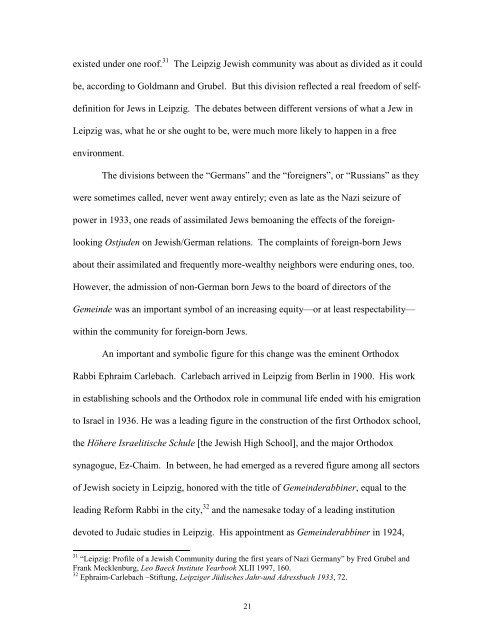Jews in Leipzig - The University of Texas at Austin
Jews in Leipzig - The University of Texas at Austin
Jews in Leipzig - The University of Texas at Austin
Create successful ePaper yourself
Turn your PDF publications into a flip-book with our unique Google optimized e-Paper software.
existed under one ro<strong>of</strong>. 31 <strong>The</strong> <strong>Leipzig</strong> Jewish community was about as divided as it could<br />
be, accord<strong>in</strong>g to Goldmann and Grubel. But this division reflected a real freedom <strong>of</strong> self-<br />
def<strong>in</strong>ition for <strong>Jews</strong> <strong>in</strong> <strong>Leipzig</strong>. <strong>The</strong> deb<strong>at</strong>es between different versions <strong>of</strong> wh<strong>at</strong> a Jew <strong>in</strong><br />
<strong>Leipzig</strong> was, wh<strong>at</strong> he or she ought to be, were much more likely to happen <strong>in</strong> a free<br />
environment.<br />
<strong>The</strong> divisions between the “Germans” and the “foreigners”, or “Russians” as they<br />
were sometimes called, never went away entirely; even as l<strong>at</strong>e as the Nazi seizure <strong>of</strong><br />
power <strong>in</strong> 1933, one reads <strong>of</strong> assimil<strong>at</strong>ed <strong>Jews</strong> bemoan<strong>in</strong>g the effects <strong>of</strong> the foreign-<br />
look<strong>in</strong>g Ostjuden on Jewish/German rel<strong>at</strong>ions. <strong>The</strong> compla<strong>in</strong>ts <strong>of</strong> foreign-born <strong>Jews</strong><br />
about their assimil<strong>at</strong>ed and frequently more-wealthy neighbors were endur<strong>in</strong>g ones, too.<br />
However, the admission <strong>of</strong> non-German born <strong>Jews</strong> to the board <strong>of</strong> directors <strong>of</strong> the<br />
Geme<strong>in</strong>de was an important symbol <strong>of</strong> an <strong>in</strong>creas<strong>in</strong>g equity—or <strong>at</strong> least respectability—<br />
with<strong>in</strong> the community for foreign-born <strong>Jews</strong>.<br />
An important and symbolic figure for this change was the em<strong>in</strong>ent Orthodox<br />
Rabbi Ephraim Carlebach. Carlebach arrived <strong>in</strong> <strong>Leipzig</strong> from Berl<strong>in</strong> <strong>in</strong> 1900. His work<br />
<strong>in</strong> establish<strong>in</strong>g schools and the Orthodox role <strong>in</strong> communal life ended with his emigr<strong>at</strong>ion<br />
to Israel <strong>in</strong> 1936. He was a lead<strong>in</strong>g figure <strong>in</strong> the construction <strong>of</strong> the first Orthodox school,<br />
the Höhere Israelitische Schule [the Jewish High School], and the major Orthodox<br />
synagogue, Ez-Chaim. In between, he had emerged as a revered figure among all sectors<br />
<strong>of</strong> Jewish society <strong>in</strong> <strong>Leipzig</strong>, honored with the title <strong>of</strong> Geme<strong>in</strong>derabb<strong>in</strong>er, equal to the<br />
lead<strong>in</strong>g Reform Rabbi <strong>in</strong> the city, 32 and the namesake today <strong>of</strong> a lead<strong>in</strong>g <strong>in</strong>stitution<br />
devoted to Judaic studies <strong>in</strong> <strong>Leipzig</strong>. His appo<strong>in</strong>tment as Geme<strong>in</strong>derabb<strong>in</strong>er <strong>in</strong> 1924,<br />
31 “<strong>Leipzig</strong>: Pr<strong>of</strong>ile <strong>of</strong> a Jewish Community dur<strong>in</strong>g the first years <strong>of</strong> Nazi Germany” by Fred Grubel and<br />
Frank Mecklenburg, Leo Baeck Institute Yearbook XLII 1997, 160.<br />
32 Ephraim-Carlebach –Stiftung, <strong>Leipzig</strong>er Jüdisches Jahr-und Adressbuch 1933, 72.<br />
21

















